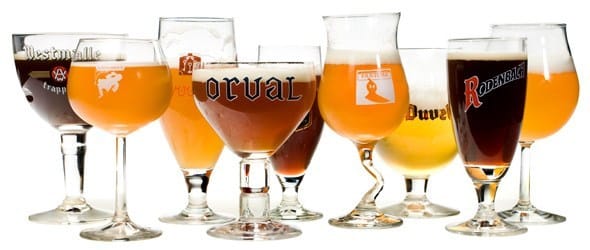By SUE QUIGLEY
HERNANDO SUN WRITER
Belgium: A tiny little country but huge on beer!
When you think of Europe and beer, Germany springs to mind, Ireland or even the Czech Republic, the ancestral home of Budweiser.
But Belgium has probably the widest selection of beers in the world and can brew delicious, fruity beers from practically anything — cherries, raspberries, strawberries, apricots, honey, orange peels, cinnamon, black pepper, nuts, chocolate and even wheat. So many of these wheat beers can now be seen to be gracing the shelves in Publix.
Belgian beers are diverse and vary from pale lager to amber ales, Flemish red ales, brown ales, strong ales and stouts.
The natives, on average, drink 84 litres of beer a year and you’ll find a huge range of beers in the smallest of cafés, bistros or restaurants.
Almost every monastery and farmyard in tiny Belgium (population around 11 million) has its own label and brewery. Over 100 licensed Belgian breweries make at least 700 different specialty beers, mostly bottled. Impressive, but the numbers still pale compared to France’s production of wines and cheeses.
Taste range gives Belgian beers their world-class advantage. That, and they’re fermented two or three times as long as American beers, which are marketed on freshness and heavily carbonated. Some Belgian beers are fermented for as long as five years in oak casks or dark brown glass bottles.
Belgian wheat beers, called Lambics, are something else. True lambic is brewed in Brussels, in the Pajottenland-Zennevallei rural area to the west and made from Belgian waters rich in self-fermenting wild yeasts.
Brewers of lambic beers like to leave things up to chance. The beers are left in open vats where wild yeast and bacterias are allowed to ferment then stored in barrels and left to age for up to three years. The process gives the beer its distinctive flavour: dry, cidery and with a bit of an aftertaste. Very strong in alcohol — 8 to 11 percent alcohol content — downing a couple of these beers is much like drinking a couple of bottles of wine. Establishments often serve lambics by the pitcher diluted with Champagne or Guinness.
Other Belgian beers worth mentioning are the abbey beers which are brewed traditionally from centuries-old Trappist recipes. Trappist beers are brewed in six monasteries by genuine Trappist monks. In order to be called a Trappist beer, the beer must be brewed within the monastery walls.
You might be thinking Belgium is a nation of alcoholics but they usually drink ordinary pale, not-so-strong Jupiler or Maes lagers. They’re served warm, like British beer.
Yet, Belgium isn’t all about booze. The country serves up some of the world’s finest lamb and beef and authentic fries to go with them.
Americans call them ”French” fries, but despite their name, they are actually a Belgian invention, and pommes frites are served with mayonnaise, not ketchup.
Almost half the country is French-speaking; the rest speak Flemish, a slight adaption of Dutch.
Frites are probably the ultimate in Belgian fast food today. They’re sold in little triangular cardboard cones from street vendors everywhere. Real Belgian pommes frites are fried twice. The first time cooks them through and makes them tender. The second cooking turns them golden brown and seriously crisp.
Skirting the North Sea, Belgians are also partial to lobster, mussels, eel and pickled herring with their fries. The mussels, steamed in a white wine sauce, are usually washed down with a gulp of Genever — a gin-like drink made from juniper berries.
On many occasions, I’ve sat outside a café on a cold, snowy morning in Brussels sipping Genevers while waiting on pommes frites and Waterzooi — a thick broth made from seafood, egg yolks, cream and herbs like parsley, thyme, bay leaves and sage. However, today, the stew is more commonly made with chicken than expensive seafood.
Throughout Belgium, vendors also serve Belgian waffles with a whole variety of accompaniments: red jam, fresh fruit, chocolate or maybe whipped cream. But Belgians are not at all fond of pouring syrup all over their waffles.
Americans like to think Swiss chocolate is the world’s best. Not so! Belgian chocolate even makes the Swiss drool. It’s made with real milk and contains no chemical preservatives or artificial flavourings.
Belgium has a long tradition of chocolate making and Jean Neuhaus is often referred to as Belgium’s most famous chocolatier. The Neuhaus chocolatier manufactures and sells luxury chocolates, truffles, biscuits and ice cream worldwide.
Part of Belgium’s culture, the Belgians churn out approximately $12 billion worth of chocolate a year and the leading Belgian chocolate names include Neuhaus and the more upscale Wittamer. Godiva chocolates are now sold throughout the US.
Belgian dark chocolate is made with extra helpings of cocoa bean paste, and is allegedly good for what might ail you, like high blood pressure.
Belgian food and beer might just be what the doctor ordered.

